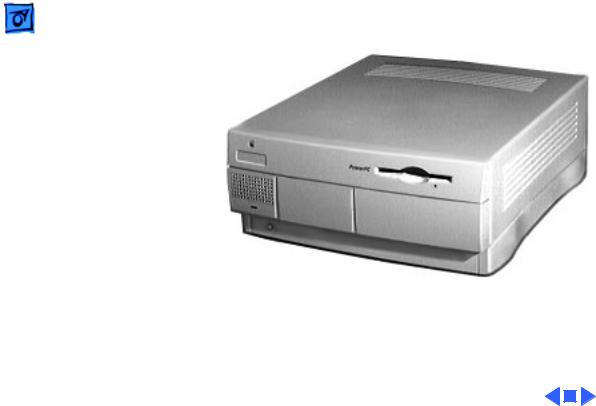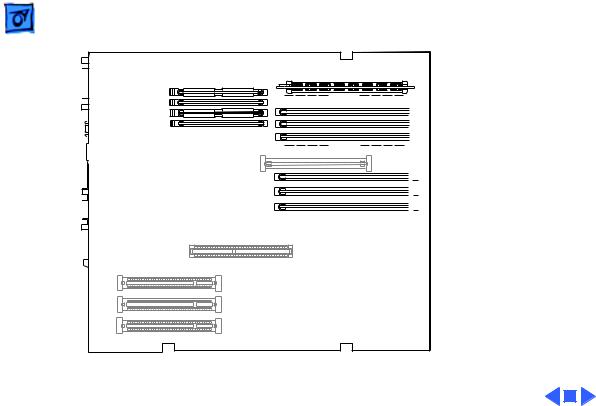Apple Macintosh Powermac Performa WS7350 Service Manual

K Service Source
Power Macintosh 7300/
7500/7600 & WS 7350
PM 7300/166 (Europe/Japan only), 7300/180 & 180PC, 7300/200, 7500/100, 7600/120, 7600/ 132, 7600/200 (Japan only), and WS 7350/180

K Service Source
Basics
Power Macintosh 7300/7500/
7600 & WS 7350

Basics |
Overview - 1 |
|
|
|
|
Overview
The Power Macintosh 7300, 7500, and 7600 and WS 7350 share the same housing and feature a chassis design that allows you to access the logic board and its components (including the plug-in microprocessor card) without having to remove the power supply or any drives. This flexible design makes these systems easy to service and upgrade.
Features of the Power Macintosh 7300 include
•A 166, 180, or 200 MHz PowerPC™ 604e microprocessor card with built-in FPU and 256K cache
•16 or 32 MB of DRAM, expandable to 512 MB using 168-pin, 70 ns, 64-bit DIMMs
•2 MB VRAM, expandable to 4 MB
•2 GB hard drive
•Three PCI expansion slots

Basics |
Overview - 2 |
|
|
|
|
|
• Two SCSI DMA buses supporting up to eight SCSI devices |
|
|
and transfers up to 10 MB/s (internal bus only) |
|
|
• Built-in AAUI and 10BASE-T Ethernet |
|
|
• Two GeoPort serial ports |
|
|
• CD-ROM drive at 12x speed |
|
|
• CD-quality stereo sound in/out |
|
|
• Mac™ OS system software 7.5.5 |
|
|
Features of the Power Macintosh 7300/180 PC Compatible |
|
|
include |
|
|
A 180 MHz PowerPC™ 604e microprocessor card with |
|
|
built-in FPU and 256K cache |
|
|
• 32 MB of DRAM, expandable to 512 MB using 168-pin, |
|
|
70 ns, 64-bit DIMMs |
|
|
• 2 MB VRAM, expandable to 4 MB |
|
|
• 2 GB hard drive |
|
|
• Three PCI expansion slots |
|

Basics |
Overview - 3 |
|
|
|
|
|
• Two SCSI DMA buses supporting up to eight SCSI devices |
|
|
and transfers up to 10 MB/s (internal bus only) |
|
|
• Built-in AAUI and 10BASE-T Ethernet |
|
|
• Two GeoPort serial ports |
|
|
• CD-ROM drive at 12x speed |
|
|
• CD-quality stereo sound in/out |
|
|
• Mac™ OS system software 7.6.1 |
|
|
• 166 MHz Pentium processor card with FPU, 256K Level |
|
|
2 cache, 16 MB of DRAM (expandable to 80 MB), 2 MB |
|
|
of video DRAM |
|
|
• Windows 95 system software preinstalled |
|
Features of the Power Macintosh 7500 include
•A 100 MHz PowerPC 601 microprocessor card with built-in FPU and optional Level 2 cache
•8 or 16 MB DRAM expansion up to 512 MB using 168pin, 70 ns, 64-bit DIMMs
•2 MB VRAM, expandable to 4 MB

Basics |
Overview - 4 |
|
|
|
|
|
• 500 MB or 1 GB hard drive |
|
|
• Two SCSI DMA buses supporting up to eight SCSI devices |
|
|
and transfers up to 10 MB/s (internal bus only) |
|
|
• Three PCI expansion slots |
|
|
• One Digital Audio Video (DAV) slot |
|
|
• Video-in support via external ports |
|
|
• Built-in AAUI and 10BASE-T Ethernet |
|
|
• Two GeoPort serial ports |
|
|
• CD-ROM drive at 4x speed |
|
|
• CD-quality stereo sound in/out |
|
|
• Mac OS system software 7.5.2 |
|
Features of the Power Macintosh 7600 (U.S.) include
•A 120 or 132 MHz PowerPC 604 microprocessor card with built-in FPU and 256K cache
•16 MB of DRAM, expandable to 512 MB using 168-pin, 70 ns, 64-bit DIMMs
•2 MB VRAM, expandable to 4 MB

Basics |
Overview - 5 |
|
|
|
|
|
• 1.2 GB hard drive |
|
|
• Two SCSI DMA buses supporting up to eight SCSI devices |
|
|
and transfers up to 10 MB/s (internal bus only) |
|
|
• Three PCI expansion slots |
|
|
• One Digital Audio Video (DAV) slot |
|
|
• Video-in support via external ports |
|
|
• Built-in AAUI and 10BASE-T Ethernet |
|
|
• Two GeoPort serial ports |
|
|
• CD-ROM drive at 4x or 8x speed |
|
|
• CD-quality stereo sound in/out |
|
|
• Mac OS system software 7.5.3 |
|
|
Features of the Power Macintosh 7600/200 (Japan only) |
|
|
include |
|
|
• A 200 MHz PowerPC 604e microprocessor card with |
|
|
built-in FPU and 256K cache |
|
|
• 32 MB of DRAM, expandable to 512 MB using 168-pin, |
|
|
70 ns, 64-bit DIMMs |
|

Basics |
Overview - 6 |
|
|
|
|
|
• 2 MB VRAM, expandable to 4 MB |
|
|
• 2 GB hard drive |
|
|
• Two SCSI DMA buses supporting up to eight SCSI devices |
|
|
and transfers up to 10 MB/s (internal bus only) |
|
|
• Three PCI expansion slots |
|
|
• One Digital Audio Video (DAV) slot |
|
|
• Video-in support via external ports |
|
|
• Built-in AAUI and 10BASE-T Ethernet |
|
|
• Two GeoPort serial ports |
|
|
• CD-ROM drive at 12x speed |
|
|
• CD-quality stereo sound in/out |
|
|
• Support for TCP/IP networking software with Apple |
|
|
Open Transport |
|
|
• Mac OS system software 7.5.5 |
|
|
Features of the Workgroup Server 7350/180 include |
|
|
• A 180 MHz PowerPC 604e microprocessor card with |
|
|
built-in FPU, 64K on-chip cache, and 256K Level 2 |
|

Basics |
Overview - 7 |
|
|
|
|
|
cache |
|
|
• 48 MB of DRAM, expandable to 512 MB using 168-pin, |
|
|
70 ns, 64-bit DIMMs |
|
|
• 2 MB VRAM, expandable to 4 MB |
|
|
• 4 GB hard drive |
|
|
• Two SCSI DMA buses supporting up to eight SCSI devices |
|
|
and transfers up to 10 MB/s (internal bus only) |
|
|
• Three PCI expansion slots |
|
|
• Built-in AAUI and 10BASE-T Ethernet |
|
|
• Two GeoPort serial ports |
|
|
• CD-ROM drive at 12x speed |
|
|
• CD-quality stereo sound in/out |
|
|
• Mac™ OS system software 7.6.1 |
|
|
• Apple RAID 1.5 |
|
|
The Power Macintosh 7300, 7500, and 7600 Series and WS |
|
|
7350 computer is pictured on the following page. |
|

Basics |
Overview - 8 |
|
|
|
|
Figure: PM 7300/7500/7600 & WS 7350 Computer

 Basics Configurations - 9
Basics Configurations - 9
Configurations
The Power Macintosh 7300/166 comes standard with
• 166 MHz PowerPC 604e microprocessor card
• 16 MB DRAM
• 2 GB hard drive
• AppleCD 1800i 12x CD-ROM drive
• 2 MB of VRAM
• 256K Level 2 cache
The Power Macintosh 7300/180 comes standard with
• 180 MHz PowerPC 604e microprocessor card
• 16 MB DRAM
• 2 GB hard drive
• AppleCD 1800i 12x CD-ROM drive
• 2 MB of VRAM
• 256K Level 2 cache

Basics |
Configurations - 10 |
|
|
|
|
|
The Power Macintosh 7300/180 PC Compatible comes |
|
|
standard with |
|
|
• 180 MHz PowerPC 604e microprocessor card |
|
|
• 32 MB of DRAM |
|
|
• 2 GB hard drive |
|
|
• AppleCD 1800i 12x CD-ROM drive |
|
|
• 2 MB of VRAM |
|
|
• 256K Level 2 cache |
|
|
• 166 MHz Pentium processor card with FPU, 256K Level |
|
|
2 cache, 16 MB of DRAM, 2 MB of video DRAM |
|
|
The Power Macintosh 7300/200 comes standard with |
|
|
• 200 MHz PowerPC 604e microprocessor card |
|
|
• 32 MB DRAM |
|
|
• 2 GB hard drive |
|
|
• AppleCD 1800i 12x CD-ROM drive |
|
|
• 2 MB of VRAM |
|
|
• 256K Level 2 cache |
|

Basics |
Configurations - 11 |
|
|
|
|
|
The Power Macintosh 7500/100 comes standard with |
|
|
• 100 MHz PowerPC 601 microprocessor card |
|
|
• 8/16 MB DRAM |
|
|
• 500 MB or 1 GB hard drive |
|
|
• AppleCD 600i 4x CD-ROM drive |
|
|
• 2 MB of VRAM |
|
|
The Power Macintosh 7600/120 comes standard with |
|
|
• 120 MHz PowerPC 604 microprocessor card |
|
|
• 16 MB DRAM |
|
|
• 1.2 GB hard drive |
|
|
• AppleCD 600i 4x CD-ROM drive |
|
|
• 2 MB of VRAM |
|

Basics |
Configurations - 12 |
|
|
|
|
|
The Power Macintosh 7600/132 comes standard with |
|
|
• 132 MHz PowerPC 604 microprocessor card |
|
|
• 16 MB DRAM |
|
|
• 1.2 GB hard drive |
|
|
• AppleCD 1200i 8x CD-ROM drive |
|
|
• 2 MB of VRAM |
|
|
The Power Macintosh 7600/200 comes standard with |
|
|
• 200 MHz PowerPC 604e microprocessor card |
|
|
• 32 MB DRAM |
|
|
• 2 GB hard drive |
|
|
• AppleCD 1800i 12x CD-ROM drive |
|
|
• 2 MB of VRAM |
|
|
• 256K Level 2 cache |
|

Basics |
Configurations - 13 |
|||
|
|
|
||
|
The Workgroup Server 7350/180 comes standard with |
|||
|
• 180 MHz PowerPC 604e microprocessor card |
|||
|
• 48 MB DRAM |
|||
|
• 4 GB hard drive |
|||
|
• AppleCD 12x CD-ROM drive |
|||
|
• 2 MB of VRAM |
|||
|
• 256K Level 2 cache |
|||
|
In addition, there are three solution bundles for the WS |
|||
|
7350/180: |
|
|
|
|
• Application Server Solution |
|||
|
• AppleShare Server Solution |
|||
|
• Apple Internet Server Solution |
|||
|
|
|
|
|
|
|
|
|
|

Basics |
PowerPC 601 Microprocessor - 14 |
|
|
|
|
PowerPC 601 Microprocessor
The Power Macintosh 7500/100 features the PowerPC 601 RISC microprocessor. The PowerPC 601 microprocessor is installed via a card that plugs into the Macintosh 7500/100 logic board, allowing for maximum flexibility with future upgrades.
Features of the microprocessor include
•Full RISC processor architecture
•32-bit addressing
•64-bit data bus
•Built-in FPU
•32K cache for data and instructions
•Internal Memory Management Unit (MMU)
•Advanced branching techniques for improved throughput

Basics |
PowerPC 604 and 604e Microprocessor - 15 |
|
|
|
|
PowerPC 604 and 604e Microprocessor
The Power Macintosh 7300 and 7600 and Workgroup Server 7350 computers feature the PowerPC 604 and 604e RISC microprocessor. The microprocessor is installed via a card that plugs into the logic board, allowing for maximum flexibility with future upgrades.
Features of the microprocessor include
•Full RISC processing architecture
•Parallel processing units: one load-store unit, two integer units, one complex integer unit, and one floating point unit
•Separate built-in caches for data and instructions, 16K each for the 604 and 32K each for the 604e
•Advanced branching techniques for improved throughput
•Bus multiplier up to 3:1 for the 604 and up to 5:1 for the 604e

Basics |
Peripheral Component Interconnect (PCI) - 16 |
|
|
|
|
Peripheral Component Interconnect (PCI)
All the computer systems covered in this manual offer a Peripheral Component Interconnect (PCI) expansion bus. Because the PCI bus is an industry standard, most existing PCI 2.0-compliant cards (with the addition of a Mac OSspecific software driver) will work in these computers.
PCI offers significantly higher performance than the NuBus architecture used in previous Macintosh models. Running at 33 MHz, the PCI bus is up to three times faster than NuBus, offering overall enhanced system performance, particularly in the areas of video and networking.

Basics |
Dual In-Line Memory Modules (DIMMs) - 17 |
|
|
|
|
Dual In-Line Memory Modules (DIMMs)
All the computer systems covered in this manual use DRAM Dual In-Line Memory Modules (DIMMs) instead of DRAM SIMMs. Whereas SIMMs have 72 pins, DIMMs have 168 pins. The extra pins provide a 64-bit data path, compared to a 32-bit data path for SIMMs. In addition, DIMMs do not have to be installed in pairs like the SIMMs on earlier Macintosh models. (However, to take advantage of memory interleaving, the DIMMs should be installed in paired slots. See “Memory Configurations” in Basics for more information.)
Important: These computers use +5 V DIMMs only. Single In-Line Memory Modules (SIMMs) used in previous Macintosh models are NOT compatible with these computers.

Basics |
Dual In-Line Memory Modules (DIMMs) - 18 |
|||
|
|
|
||
|
Important: These computers also use VRAM DIMMs (112- |
|||
|
pin 70 ns or faster) instead of VRAM SIMMs. The VRAM |
|||
|
SIMMs used in earlier Power Macintosh models are not |
|||
|
compatible. |
|||
|
Note: While the Power Macintosh 7300 Series, the Power |
|||
|
Macintosh 7600/200, and the Workgroup Server 7350/ |
|||
|
180 ship with EDO DIMMs, the computers’ memory |
|||
|
controller treats EDO DIMMs like fast-paged DIMMs. You |
|||
|
can therefore use either EDO or fast-paged DIMMs in these |
|||
|
computers. |
|||
|
|
|
|
|
|
|
|
|
|

Basics |
Memory Configurations - 19 |
|
|
|
|
Memory Configurations
All the computer systems covered in this manual have eight DRAM DIMM slots on the logic board, each with a 64-bit data bus. You can increase the computers’ DRAM to a total of 512 MB using 5-volt, 64-bit-wide, 168-pin fast-paged mode, 70 ns DIMMs. (You can also use EDO DIMMs in the PM 7300 Series, 7600/200, and WS 7350/180. See the note on the previous page for more information.)
Note: These computers do not have any main memory soldered to the logic board. At least one RAM DIMM must be present for the computers to operate.
DRAM DIMMs can be installed individually; however, to take advantage of the computer’s interleaving capability, which provides maximum performance, you must install the DIMMs in matching pairs and in paired slots.

Basics |
Memory Configurations - 20 |
|
|
|
|
|
Note: Memory interleaving allows the computer to read or |
|
|
write to its memory while other memory reads or writes |
|
|
are occurring, thus providing for faster performance. |
|
|
For a pair of DIMMs to function as a single 128-bit wide |
|
|
pair, they must be the same type and size. |
|
|
Note: DIMMs purchased from different manufacturers can |
|
|
be paired as long as they are the same size and speed. |
|
|
The drawing on the following page illustrates where the |
|
|
DRAM slots are located on the Power Macintosh 7300, |
|
|
7500, 7600 and WS 7350 logic boards and how they are |
|
|
numbered. |
|

Basics |
Memory Configurations - 21 |
|
|
|
|


















 B4 slot
B4 slot






 B3 slot
B3 slot





 B2 slot
B2 slot






 B1 slot
B1 slot


















 A4 slot
A4 slot



 A3 slot
A3 slot





 A2 slot
A2 slot





 A1 slot
A1 slot
(front of computer)
Figure: DRAM Slots on PM 7300/7500/7600 & WS 7350

Basics |
Ethernet Support - 22 |
|
|
|
|
Ethernet Support
There are two Ethernet ports on the logic board: an AAUI port and a 10BASE-T port. You can use only one Ethernet port at one time, however. If you have cables plugged into both Ethernet ports, the computer uses the 10BASE-T port by default.

Basics |
AV Support - 23 |
|
|
|
|
AV Support
The Power Macintosh 7500 and 7600 computers come standard with an AV module that provides support for: composite video and S-video input, audio input (left and right), and audio output (left and right). The Power Macintosh 7300 and WS 7350 computers do not include an AV module.
PC Compatibility Cards
Apple computer offers PC Compatibility Card upgrade kits that bring full DOS functionality to the Power Macintosh 7300, 7500, and 7600 computers. The cards plug into any available PCI slot on the logic board. Refer to the Upgrades chapter in this manual for installation instructions.

Basics |
GeoPort - 24 |
|
|
|
|
GeoPort
Geoport is a hardware and software communications architecture that has been optimized for computertelephony integration. It has three main attributes:
• It lets any computer connect to any telephone (analog or digital, public or private) anywhere in the world.
• Once connected, it supports an arbitrary number of independent data streams up to a total bandwidth of 2 MB/ second.
• Unlike traditional asynchronous data communications (such as AppleTalk), GeoPort also supports isochronous data streams (such as real-time voice and video) and provides the real-time Application Program Interfaces (APIs) necessary to hide the implementation details from both the recipient and the sender.

Basics |
GeoPort - 25 |
|||
|
|
|
||
|
By attaching an Apple GeoPort Telecom Adapter to the Power |
|||
|
Macintosh 7300, 7500, or 7600, you can enjoy all the |
|||
|
features of a 33.6 modem, including data, fax, send and |
|||
|
receive, and voice capabilities. The GeoPort Telecom Adapter |
|||
|
serves as a line interface to standard (analog) telephone |
|||
|
lines. The adapter is capable of sending or receiving data at |
|||
|
up to 33.6 kbps and faxes at up to 14.4 kbps using the |
|||
|
GeoPort Telecom Adapter software. |
|||
|
|
|
|
|
|
|
|
|
|

 Basics The Cuda Chip - 26
Basics The Cuda Chip - 26
The Cuda Chip
The Cuda is a microcontroller chip. Its function is to
• Turn system power on and off
• Manage system resets from various commands
• Maintain parameter RAM (PRAM)
• Manage the Apple Desktop Bus (ADB)
• Manage the real-time clock
Many system problems can be resolved by resetting the Cuda chip (see Symptom Charts for examples). Press the Cuda reset button on the logic board to reset the Cuda chip. (See "Logic Board Diagram" later in this chapter to locate the Cuda reset button.) If you continue to experience system problems, refer to “Resetting the Logic Board” later in this Basics chapter.

Basics |
Resetting the Logic Board - 27 |
|
|
|
|
Resetting the Logic Board
Resetting the logic board can resolve many system problems (refer to "Symptom Charts" for examples). Whenever you have a unit that fails to power up, you should follow this procedure before replacing any modules.
1Unplug the computer.
2Remove the battery from the logic board. (See Take Apart for instructions on how to remove the battery.)
3Disconnect the power supply cable from the logic board and then press the Power On button. (See "Logic Board Diagram" later in this chapter to locate the Power On button.)
4Wait at least 10 minutes before replacing the battery.

Basics |
Resetting the Logic Board - 28 |
|||
|
|
|
||
|
5 Make sure the battery is installed in the correct +/- |
|||
|
direction. |
|||
|
6 Reassemble the computer and test the unit. |
|||
|
Note: This procedure resets the computer’s PRAM. Be sure |
|||
|
to check the computer’s time/date and other system |
|||
|
parameter settings afterwards. |
|||
|
Note: If this procedure resolves the problem, claim an |
|||
|
adjustment on an SRO. If not, replace the defective |
|||
|
component and DO NOT claim the adjustment procedure. |
|||
|
|
|
|
|
|
|
|
|
|
